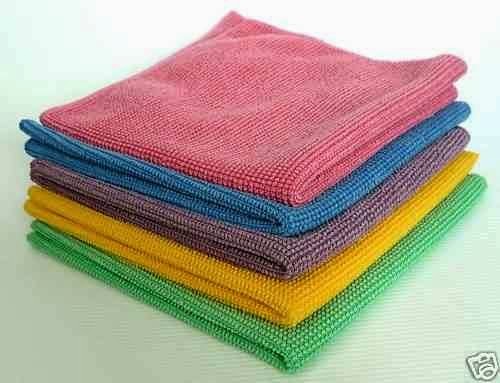 |
| Photo:aliexpress |
Cleaning cloths are of many types, some are better than others, depending on what it is used. It's very different to clean wooden furniture or stainless steel kitchen. In addition you also have to take into account, how to keep them so they are always right and if they should be of a particular color. The composition is also very important, as is usually the best 100 % cotton, with synthetic fibers is almost impossible to clean ...
To clean dust are fine microfibers. The shape of the fiber gives them a high absorption capacity and in fact absorbs twice the cotton. Generally are thin and light, and have the advantage that we don’t need use any cleaning product. Withstand many washings and high temperatures, won’t warp, shrink or enlarge. Wash them to keep them in good condition at 40°C and when dry in the dryer, use a program with low temperature and do not dry them at all: if you let them a little wet , better clean the dust.
The microfibers are very practical for cleaning bathrooms, or used slightly damp with a little product for fast cleaning or very wet to clear after a thorough cleaning.
For the kitchen area we suggest the following:- Drying dishes and glassware, the better the cotton, no matter if they are grooved, but its composition has mostly cotton. The Microfiber abound, not because they do not dry well absorbing components. Better make that 100% cotton and cuddly, capable of adapting to the piece to dry. The ideals are ones that have the most sunken squares, like a sort of “honeycomb”.
- To dry pots and less delicate items are very useful called curly cotton cloths, which are like towels dry hands.
- To clean the work areas of the kitchen, if stainless steel is also used to rinse, after using white fiber, hot water and soap - microfibers with plenty of hot water. We dry immediately with a towel to avoid leaving water fences.
- Use different dishcloths when handling meat and fish. To not go wrong, you can, for example, buy white dishcloths for meats and fish, and other foods, use dishcloths of other colors.
- Do not dry your hands in a cloth directly after handling raw foods. Before, wash your hands well.
- Wash dishcloths and cloths often sanitize them: Add a splash of vinegar to the wash water. From time to time should be used for dishcloths, which tend to accumulate a lot of fat, type Solvay soda or sodium carbonate, can be soaked cloths hours or directly put the soda in the washing machine.
- The dishcloths should be kept clean and dry, because wet facilitates the spread of germs. Do not keep ever wet. Change them every 24 hours if you cook daily.
Did you know... ? There is a color code for the cloths, which prevents errors and
 |
| Photo:estiloesactitud.cl |
Red: To clean and disinfect toilets and high-risk areas in bathrooms
Yellow: To clean sinks, mirrors and low-risk areasGreen: To clean areas where food handled and stored
Blue: For all other areas and surfaces

.jpg)






